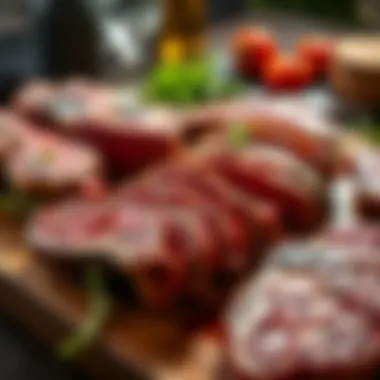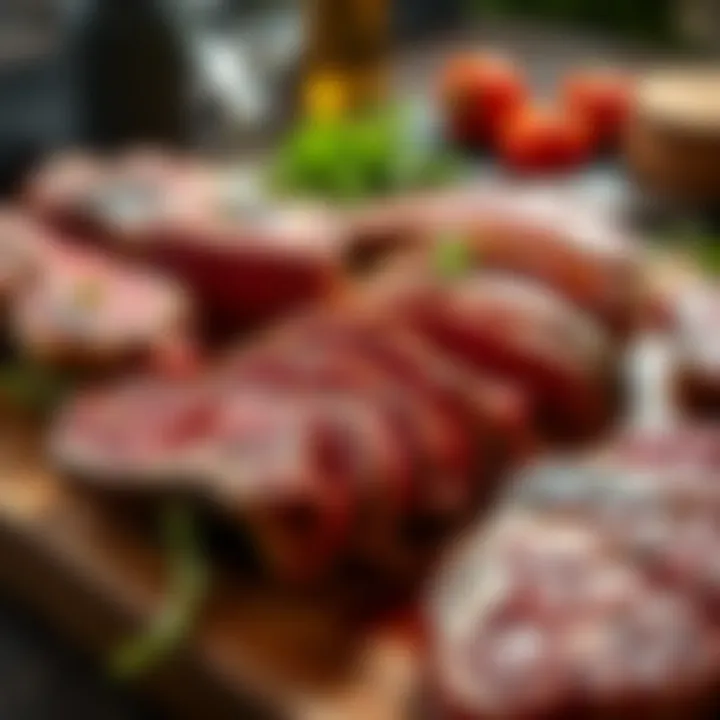Mastering the Art of Ordering Steak in Restaurants


Intro
Dining at a steakhouse can often feel like stepping into uncharted territory, especially for the uninitiated. The range of choices, from ribeye to filet mignon, can make even the boldest eater hesitate. Understanding the nuances associated with ordering steak not only enhances your palate but also demonstrates a refinement that can impress fellow diners. This guide is designed to illuminate that path, empowering you to navigate menus like a seasoned connoisseur.
A well-ordered steak isn’t just about choosing a cut; it’s a veritable art form. The experience weaves through the lush tapestry of flavor profiles, cooking methods, and even wine pairings. Recognizing how to articulate your preferences with precision can transform the meal from merely filling to profoundly enjoyable.
In this comprehensive guide, we will delve into the elements that define the steak ordering experience, exploring cuts of meat, cooking preferences, and effective communication with servers. By breaking the process down into manageable segments, readers will gain clarity on how to select the right steak, take advantage of menu nuances, and even address any special requests. For those who cherish the experience of fine dining — or simply aspire to — understanding how to order a steak is an indispensable skill, akin to fine-tuning a musical instrument or mastering a classic recipe.
Understanding Steak Cuts
When it comes to ordering steak, understanding the various cuts is like knowing the difference between a diamond and a rock. Each cut offers its own set of textures, flavors, and cooking behaviors, which can elevate or diminish your dining experience. Whether you’re opting for a simple dinner or looking to impress on a special occasion, grasping the nuances of steak cuts is essential. The right choice can make the distinction between a meal you’ll rave about to friends and one you’d prefer to forget.
Popular Cuts Explained
Tenderloin
The tenderloin is often regarded as the most premium cut, known for its buttery tenderness. It is the eye of the beef, if you will, prized for its neutral flavor and soft texture. When properly cooked, it offers a melt-in-your-mouth experience that many meat lovers seek. This cut’s lack of fat means it’s lean, making it an excellent choice for those looking for a lighter yet sumptuous steak. However, the downside is that it may lack the rich beefy flavor that other cuts possess.
Ribeye
Ribeye is a cut known for its rich marbling and robust flavor. This makes it a popular choice for steak enthusiasts who appreciate a hearty bite. The marbling not only provides flavor but also keeps the steak juicy during cooking. A well-prepared ribeye can offer a delicious balance of tender meat and indulgent fat that sets it apart from other cuts. However, those who are watching their fat intake might find it less appealing due to its higher fat content.
Sirloin
Sirloin strikes a balance between flavor and tenderness, making it a solid choice for numerous situations. It’s often less expensive than the tenderloin and ribeye, which may appeal to the budget-conscious diner. This cut is versatile, working well in both grilling or pan-searing. On the flip side, sirloin might not always be as tender as some of the pricier options, but it packs enough flavor to satisfy most steak lovers.
T-Bone
T-Bone steaks offer a two-for-one deal, featuring both the tenderloin and the strip steak in one cut. It’s often celebrated for its combination of textures and flavors, providing two different experiences in a single slice. The T-Bone is a staple for a classic steak experience, perfect for sharing or indulging alone. However, its thickness can sometimes pose a challenge for cooking evenly, requiring a bit of know-how to achieve the ideal doneness.
Less Common Cuts
Flank
Flank steak has gained a bit of popularity, especially in dishes like fajitas or stir-fry. This cut is long and flat, with a grain that runs the length of the steak, which contributes to its unique texture. Its robust flavor makes it ideal for marinades, yet it can become tough if overcooked. Flank is often overlooked, but when prepared correctly, it can be a flavorful addition to any steak lover's repertoire.
Skirt
Much like flank steak, skirt steak is packed with flavor and is perfect for marinating. Skirt is known for its long, thin cut and has a pronounced grain and rich taste, making it ideal for quick cooking methods like grilling or searing. It can be very rewarding if cooked and sliced right, but it can also turn chewy if treated carelessly. Its unique flavor profile and texture make it a cut that’s often favored among enthusiasts, but it requires technique to shine.
Chuck Eye
Chuck eye steak, often called the "poor man’s ribeye," offers a great balance of flavor and tenderness at a more approachable price point. Located near the ribeye, it has some of the same marbling, giving it a beefy flavor that many adore. While it might not have the same level of tenderness as its pricier counterparts, it's a fantastic option for those looking to enjoy a flavorful steak without breaking the bank.
Cooking Preferences
When it comes to ordering steak, understanding your cooking preferences is like learning a new language. It’s vital to know what you want, as the way your steak is cooked can significantly impact your overall dining experience. Each level of doneness brings its own unique taste and texture. So, it will benefit you utmost to grasp the nuances behind these preferences for a more satisfying meal.
Doneness Levels
Steak doneness isn’t just a trend; it reflects how the meat interacts in cooking. From juicy and blood red to charred and dry, the doneness level can make or break your plate. Here’s a breakdown of the different doneness levels you might encounter on a menu:
Rare
Rare steak is often described as slightly warm, with a cool, red center. This level retains the most natural flavor of the meat, providing an unadulterated savored experience. Many steak aficionados argue that it showcases the beef’s rich character more than any other method. However, it’s important to keep in mind that bacteria can be a concern, as this preparation barely cooks the meat. Despite the risks, its tenderness and burst of flavor make it a popular choice for those who appreciate authentic beef taste.
Medium Rare
If Rare is singing a solo, Medium Rare is the harmony that makes the dish complete. This doneness seals in the juices while still keeping the center pink and warm, something many steak lovers can’t resist. The meat is tender and juicy, providing a perfect balance between flavor and texture. A well-cooked Medium Rare steak can appeal to both seasoned diners and those exploring their preferences. However, it’s crucial that steaks are cooked correctly—overcooking this level can lead you to lose that succulent experience.
Medium


Medium steaks are often the safe choice for those who aren’t keen on rawness. The meat appears pink but will transition more towards gray as cooking progresses, often resulting in a firmer texture. While some enjoy this level for its evenly distributed flavor, it's often been criticized for lacking the delicious juiciness that its friends, Rare and Medium Rare, deliver. Some patrons enjoy the consistency and robustness Medium brings to the table, making it an acceptable and comfortable choice.
Medium Well
When you reach this stage, you’re approaching the harried area between juiciness and dry. Medium Well steak is mostly brown with just a hint of pink left. It’s an option favored by those who prefer their beef well-cooked but still recognize it as steak rather than a charcoal brick. The challenge here is to coax out enough moisture to make it enjoyable. Although not as juicy as lower levels, some appreciate its more cooked flavor and the heavy texture that accompanies it.
Well Done
Well Done steak is often a divisive topic among steak lovers. It’s cooked all the way through, leaving no trace of pink and giving it a gray appearance. While this level is a common request from those who prefer fully cooked meat, it often loses the tenderness and rich flavor that steak enthusiasts covet. Overcooking can sometimes result in a chewy texture, taking away from the overall enjoyment. Still, for those who enjoy a firmer bite, it’s a commendable choice.
Why Doneness Matters
Understanding doneness is crucial not only for ensuring satisfaction but also for aligning your taste with the meal you select. Each level of doneness influences how flavors are expressed and how the steak feels in your mouth. When you order your steak correctly, you unlock juicy moments that might connect better with your palate. On top of that, many steakhouses pride themselves on their ability to cook meat to your preference perfectly. Communicating your choice effectively can elevate your dining experience to that next level.
Navigating the Menu
Understanding how to navigate a steakhouse menu is not just about discerning what dish to order; it's an essential skill that can significantly enhance your steak-eating experience. Many diners find themselves overwhelmed by the listings of cuts, cooking styles, and accompanying dishes. By grasping the fundamentals of menu navigation, you can make informed decisions that align with your tastes and preferences. Doing so not only enriches your dining experience but also underscores your confidence as a patron.
Reading Descriptions
The descriptions listed on a menu often hold the key to unlocking a great meal. It’s easy to gloss over these textual nuggets, but taking a moment to digest the details can be enlightening. Menus frequently provide insights into the cut's specific preparation methods, seasonings used, and any accompanying sauces or sides. For example, a steak may be described as "charbroiled with a house-made chimichurri," indicating both flavor and preparation style. Keeping an eye out for these terms can help you identify offerings that sing to your palate.
Consider also that terms like "grass-fed," "dry-aged," or "marble score" can influence which cut is right for you. If you see "dry-aged Ribeye" on the menu, you’re looking at a steak that’s likely to be more flavorful and tender than its fresh counterpart. This kind of intel can be pivotal in your ordering process.
Additionally, it’s wise to pay attention to the favorites of the house or any chef’s specials. These dishes often reflect seasonal ingredients and highlight the chef’s expertise. So, when you see a steak paired with a seasonal vegetable, understand it may represent the chef's top-choice offering, crafted with care.
Identifying Specialties
Menu specialties can change from one establishment to another, as every steakhouse often puts its own unique twist on traditional offerings. Understanding the house specialties can reveal hidden gems that you may not have considered. Examples of these might include:
- Signature Marinades: Some restaurants have a secret sauce or marinade, which elevates the flavor of their steaks to an extraordinary level.
- Smoked or Grilled Options: A house specialty might be steaks cooked over an open flame or in a smoker, lending a depth of flavor that might appeal to your taste.
- Creative Pairings: Be on the lookout for interesting sides or sauces that come recommended with a particular steak. Certain cuts may go exceptionally well with unique accompaniments, such as a spicy remoulade sauce or roasted garlic mashed potatoes.
When asking your server about these specialties, don't just consider what's on the menu; inquire about their standout dish or personal favorites. A knowledgeable staff member can provide insights that shift your decision-making from standard fare to a delightfully memorable meal.
"Navigating the menu is half the battle; understanding what each item brings to the table is what turns a meal into an experience."
Communicating with the Server
When it comes to ordering steak at a restaurant, effective communication with your server can make or break your dining experience. It's not just about placing an order; it's about creating a dialogue that reflects your preferences and expectations. The way you articulate your desires can ensure the meal is prepared to your liking and enhances the overall enjoyment of the dining experience.
A well-informed server acts as your guide, helping you navigate through possible choices that align with your palate. Communicating clearly can help in several ways:
- Avoid Mistakes: By clearly stating your preferences, you reduce the chances of miscommunication.
- Enhance Flavor: When you understand and convey what you enjoy, your server can make better recommendations, tailoring your meal to your taste.
- Experience Personalization: A conversation with your server can lead to personalized suggestions, making your dining experience uniquely yours.
Listening to their recommendations can open doors to new flavors, as they often know the best way to highlight the dish's qualities.
Making Your Request Clear
Being precise in your order is essential. Begin with the cut of steak you want, followed by your preferred cooking level. For instance, instead of just saying "steak," try saying, "I would like a medium-rare ribeye, please." This specificity not only helps the kitchen but also shows your server you are knowledgeable about steak.
- Be Direct: Instead of vague instructions, use clear and concise language. "No garlic, please" is preferred over saying, "Just a little less seasoning."
- Repeat Back: Once you’ve made your order, don’t hesitate to hear them repeat it back to you. This can catch any potential errors.
- Ask Questions: Don’t shy away from inquiring about how a dish is prepared or the ingredients used. A good server will appreciate your interest and provide information that can help you make a better choice.
By articulating your wishes clearly and confidently, you empower the server to meet your expectations more effectively.
Addressing Dietary Restrictions
If you have specific dietary restrictions, clear communication is crucial. It’s important not just to disappear into the ether of the menu; speak up about what you cannot eat. Servers are trained to handle these types of requests and appreciate diners who are upfront about their needs.
Here are some considerations:
- Define Your Restrictions: Instead of saying "I can't eat a lot of things," give precise instructions. For example, if you are gluten intolerant, clearly mention that you need a gluten-free option.
- Request Modifications: Many dishes can be adjusted to accommodate your needs. If the steak comes with a sauce that contains dairy, asking for it on the side or omitted altogether can often be easily done.
- Open the Dialogue: This can be a helpful opportunity to discuss side dishes or accompaniments that also fit your dietary needs. A good server can recommend alternatives that align with your restrictions.
Communicating dietary needs doesn’t have to be daunting. With careful wording and an open approach, you can ensure that your restrictions are respected, allowing you to enjoy the meal without worry.


"Clear communication is the key that unlocks the door to a flawless dining experience, especially when it comes to steak."
Accompaniments and Sides
When you're sinking your teeth into a juicy steak, it’s not just about the meat itself. The accompaniments and sides play a pivotal role in rounding out the meal, enhancing flavors, and creating a communal dining experience. Considering what to include on your plate can be just as important as choosing the perfect cut of beef. The right sides can elevate the dish, complement the steak’s rich profile, and help balance the meal, making it memorable. Here’s a closer look at classic pairings and how they contribute to a well-rounded steak dinner.
Classic Pairings
Potatoes
Potatoes are perhaps the most classic side to sit alongside a steak. Their versatility is unmatched; you can serve them mashed, baked, fried, or roasted. Each preparation brings its own flair to the table. The creamy texture of mashed potatoes can contrast beautifully with a grilled steak, making each bite a harmonious blend of flavors. Alternatively, crispy roasted potatoes can offer a satisfying crunch to offset the tenderness of the meat.
One key characteristic that makes potatoes a favored choice is their ability to absorb flavors. They can soak up sauces or juices from the steak, enhancing each forkful with a burst of flavor. However, it’s worth considering the balance—overloading on potatoes could overshadow the steak itself, so moderation is key.
Vegetables
Adding vegetables to your meal not only brings color to the plate but also incorporates freshness. Seasonal veggies, whether grilled, roasted, or sautéed, can elevate the dining experience. The slight char of grilled asparagus or the earthy notes of roasted Brussels sprouts can pair wonderfully with beef's richness. This is where you find the balance between health and indulgence.
Vegetables also provide a vital crunch and freshness, cutting through the heaviness of a steak, making the meal feel lighter. However, it’s crucial not to pick veggies that are too overpowering in flavor—think simple and complementary, rather than overwhelming.
Salads
Last but certainly not least, salads can act as a refreshing counterpart to a hearty steak. A light and crisp side salad can cleanse the palate between bites, preventing the meal from feeling too dense. Ingredients like arugula, cherry tomatoes, and a simple vinaigrette can add a burst of acidity that assists in digestion.
Salads also offer unique features, such as the crunch from nuts or a sprinkle of cheese, which can add unexpected textures to the dining experience. However, if a salad's components are too rich, like a creamy dressing, it might compete with the steak instead of complementing it.
"The beauty of a steak dinner lies not just in the steak itself but also in the harmony of its accompaniments."
Wine Pairing Principles
When it comes to enhancing a steak dinner, the right wine can often make or break the experience. Understanding the principles behind wine pairings is crucial. Red wines like Cabernet Sauvignon and Malbec typically complement beef due to their robust flavors and tannins. On the flip side, white wines or rosés can work well with lighter sides, offering a refreshing contrast. Consider the richness of both your steak and sides while making your selection to truly bring the meal together.
Ethical Considerations
Ordering steak is not merely about selecting a cut of meat; it also involves navigating a complex landscape of ethical considerations. In today's food culture, diners are increasingly aware of how their choices impact not only their own health but also the welfare of animals and the environment. Consciously addressing these elements can lead to a more satisfying dining experience, where the integrity of the food sourced takes center stage, enhancing not just flavor, but also the overall value of the meal.
Sourcing Quality Meat
When it comes to sourcing, knowing where your meat comes from is fundamental. Quality meat often originates from farms that prioritize humane treatment of animals. This means that cattle are raised in environments that allow them to express natural behaviors and are fed diets free from harmful additives. Diners should look for labels or certifications indicating the meat's quality and sourcing practices, such as USDA Organic or Certified Humane. Additionally, supporting local farms can make a significant difference. These establishments often have more stringent standards and a direct connection to the quality of their products.
There are several aspects to consider regarding sourcing:
- Farm Practices: Investigate how animals are raised and fed. Is it grass-fed or grain-fed?
- Transparency in the Supply Chain: Does the restaurant provide details about their meat suppliers?
- Quality Certifications: Look for labels that indicate high animal welfare standards.
By opting for meat that has been ethically sourced, you're not just indulging in a tasty steak; you’re also voting with your dollar for practices that are kinder to animals and better for the planet.
Sustainability in Cattle Farming
Sustainability looms large in contemporary discussions about food. Cattle farming, if not practiced responsibly, can lead to deforestation, water depletion, and significant greenhouse gas emissions. However, sustainable cattle farming approaches seek to mitigate these issues by implementing practices that keep ecological health in mind. One key concept here is rotational grazing. This involves moving cattle around various pastures to prevent overgrazing and allow for the land to recover, ultimately ensuring that cattle farming can coexist with the environment in a balanced way.
Considerations in Sustainable Practices:
- Pasture-Raised Systems: Promote biodiversity by allowing natural grasslands to flourish.
- Waste Management: Utilize manure as organic fertilizer to enrich the soil, reducing chemical inputs.
- Water Conservation: Employing techniques that minimize water waste in cattle ranching.
By being mindful of sustainability, you contribute to a greater cause. Each choice made can encourage more restaurants and farms to adopt sustainable practices, fostering an environment where dining experiences can be guilt-free and ecologically sound.
"The choices made at the dinner table today can lead to a more sustainable world tomorrow."
For further reading on sustainable meat sourcing, consider checking resources like sustainablemeat.org or localharvest.org.
Understanding these ethical considerations goes beyond simply feeling good about your meal. It's about creating a connection to the food you eat, and appreciating the effort that goes into producing it while ensuring that future generations can enjoy steak without the ethical dilemmas present today.


Steakhouse Etiquette
In the world of dining, particularly in steakhouses, etiquette plays a vital role in ensuring an enjoyable experience for everyone involved—diners and staff alike. Understanding steakhouse etiquette isn’t merely about following rules; it’s about fostering a pleasant atmosphere that respects both the food and the people who prepare it.
Good etiquette begins with recognizing the effort behind your meal. The chefs in the kitchen aren’t just cooking meat; they’re crafting an experience. When you understand the nuances of etiquette, you contribute positively to that experience, making it memorable not just for you but for your fellow diners and the restaurant employees.
Dining Behavior
When you step into a steakhouse, some unwritten rules govern your interaction with the space and its occupants. Here are some key components to keep in mind:
- Be Polite: A simple "please" and "thank you" can go a long way. Politeness isn’t just an obligation; it reflects your appreciation for the service provided.
- Dress Appropriately: Many steakhouses have a dress code. Whether it leans formal or casual, dressing properly shows respect for the venue.
- Mind the Volume: Keep your voice at a reasonable level. A jovial atmosphere is great, but loud discussions can disrupt other diners.
You wouldn’t want to walk into a fine steakhouse and treat it like a fast-food joint. It’s all about respecting the setting. Have conversations, but keep them as a backdrop to the meal quality; focus on enjoying your steak.
"Etiquette is about treating others with consideration and respect—both the culinary artists and your fellow food lovers."
Appropriate Tipping
Now, when it comes to tipping, this can be as nuanced as ordering your steak. The general rule of thumb is to tip 15-20% of the total bill, and while this is widely accepted, several factors can influence your final decision:
- Quality of Service: If your server has gone above and beyond, perhaps by offering excellent recommendations or checking in periodically, consider tipping on the higher end.
- Special Requests: If you made specific requests that complicated your order, factor that into your tip as a nod to the extra effort.
- Overall Experience: Were the steak and sides up to snuff? Did the whole experience meet expectations? Gauge your tip according to how satisfied you are with the meal.
General Considerations
- Check for Service Charges: Some steakhouses automatically include a service charge; be sure to check your bill before adding a tip.
- Handling large groups: If you’re dining with a large party, it may be wise to clarify how gratuity is handled ahead of time to avoid awkwardness.
Understanding these aspects of steakhouse etiquette contributes significantly to a successful dining experience. When you walk into a restaurant suited with honest intention and clear communication, you set the stage for enjoyment—not just for yourself but for everyone involved.
Handling Mistakes
Navigating the world of steak dining doesn’t just involve selecting the perfect cut or choosing the right wine. Sometimes, unexpected hiccups can happen, like receiving an incorrect order or feeling unsatisfied with your meal. Understanding how to handle these situations is crucial. Not only does this skill enhance your personal dining experience, but it also helps you maintain a pleasant atmosphere for servers and fellow diners. Embracing the possibility of mistakes can turn a frustrating moment into an opportunity for learning and communication.
When Your Order Is Incorrect
Imagine the scene: you eagerly await your steak, only to find the server has brought you the wrong cut or doneness. While it’s tempting to let your annoyance show, it’s essential to approach this calmly. Taking a breath and reassessing the situation can work wonders. Here’s a simple strategy:
- Stay composed: Instead of reacting impulsively, take a moment to determine what went wrong.
- Clarify your order: Politely remind the server about your original choice. Use phrases like, "I ordered a medium-rare ribeye, but I received a well-done sirloin." This keeps the conversation focused and constructive.
- Be understanding: Mistakes happen. Acknowledging that everyone can misstep can help ease tension. This goodwill fosters a better dining environment for all involved.
Mistakes can be rectified quickly, and servers appreciate it when customers express concerns in a friendly manner. Being a proactive communicator not only aids in getting your meal adjusted but also strengthens your relationship with the staff. After all, they are there to ensure you have a pleasant experience.
Expressing Concerns Politely
If you find yourself facing an issue with your meal, the manner you express your concerns can make a world of difference. It’s not just about what you say, but how you say it. Here are some thoughtful ways to outline your issues diplomatically:
- Use "I" statements: Instead of accusing, frame your experience. For example, saying "I feel that my steak isn’t cooked as I requested" sounds less confrontational than accusing them of making an error.
- Offer constructive feedback: If the steak is overcooked, explain how you expected it to taste, perhaps musing on the savory experience of a perfectly cooked medium rare. This provides context, and servers can relay your sentiments to the kitchen.
- Remember the golden rule: Treat others as you would like to be treated. A kind tone can twist misunderstandings into resolutions.
Mistakes are simply opportunities for a second chance to make things right.
Using a gentle approach might just make the server more inclined to fix your dish promptly. In the world of steak dining, manners and clarity go a long way. Ultimately, tasteful communication can transform a minor blunder into a memorable experience, ensuring you leave the restaurant content rather than disgruntled.
Post-Meal Considerations
In the world of fine dining, the experience doesn’t simply end once your plate is cleared. Post-meal considerations hold a significant place in the context of enjoying steak, not just for individual satisfaction but also for the broader dining community. Recognizing that the meal you just savored could pave the way for future improvements at the establishment makes the act of reflecting on your experience crucial. This section delves into two important aspects: Leaving Feedback and Sharing Your Experience. Both these elements, often overlooked, can enhance the overall dining ecosystem and foster relationships between patrons and restaurants.
Leaving Feedback
Constructive feedback can be the bridge that connects diners’ experiences with the restaurant's development. It is nice to express appreciation when your meal hits the spot, or to inform the staff when it’s less than satisfactory. Whether you're whispering in a manager's ear or typing up a review online, there are various avenues through which you can communicate your sentiments.
- Immediate Feedback: If something good or bad stands out while you're still at the table, let your server know. They've probably got their ear to the ground, keen on ensuring that patrons leave happy.
- Written Reviews: Online platforms, such as Yelp or TripAdvisor, allow you to provide detailed insights about your meal. This type of feedback not only helps the restaurant but informs other diners as well. Share specifics; if the steak was overcooked, steer future visitors toward the right doneness level.
- Social Media Sharing: Don't underestimate the power of platforms like Instagram and Facebook. A picture of an exquisitely presented steak can often speak volumes. Adding a caption about the taste or the service helps put your dining experience in context for a wider audience.
When crafting feedback, it’s wise to remember a balance of honesty and kindness. Striking this harmony can aid in the improvement processes of the restaurant while still maintaining a respectful tone.
Sharing Your Experience
After the last bite and the coffee settles in, many diners wish to share their encounter. This sharing can take many forms including conversations with friends, blog posts about local eateries, or even a casual chat with a neighbor.
- Word of Mouth: Don’t underestimate the effect of a simple recommendation. Telling someone about a juicy ribeye or a stellar service experience tends to resonate well. Your approval can encourage them to visit the same restaurant, generating a cycle of business.
- Blogs and Online Forums: For those with a penchant for writing, starting a personal blog or contributing to forums like Reddit can be an enjoyable way to relay experiences. Not only does this contribute to the culinary conversation, but it helps fellow steak enthusiasts avoid missteps while dining out.
- Dining Clubs and Community Groups: Joining a local foodie's group can amplify the joy of sharing experiences even further. Such communities can provide a wealth of recommendations, tips, and even group dining experiences, making the journey of food exploration richer.
In essence, the post-meal phase is not just an end, but rather a gateway. Engaging with feedback mechanisms and sharing personal experiences can not only refine your own future dining experiences but help others in their quests for a delightful meal. A great steak is a remarkable thing, but sharing the love for that meal is what truly creates culinary community.







